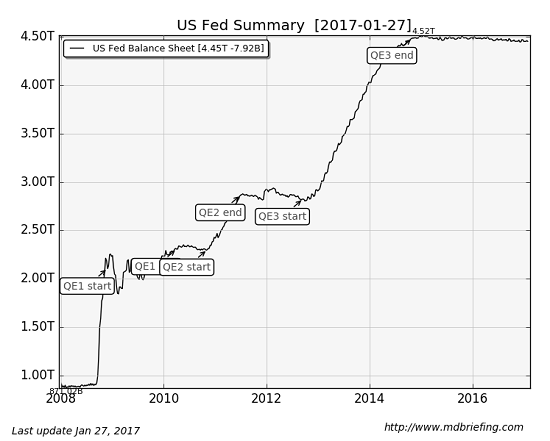
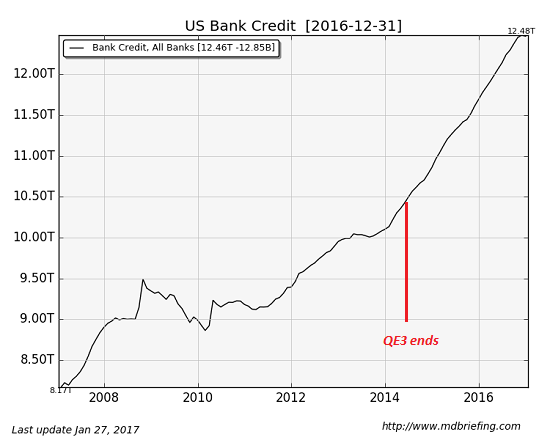
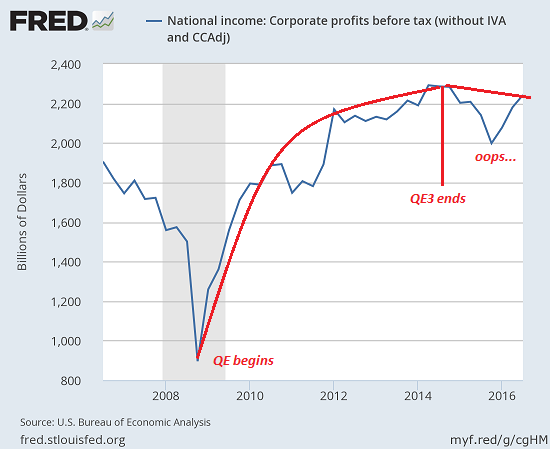
News and views on the coming collapse
Home » Posts tagged 'wealth inequality' (Page 2)
I’ve long held that if a problem can be solved by creating $1 trillion out of thin air and buying a raft of assets with that $1 trillion, then central banks will solve the problem by creating the $1 trillion out of thin air—nothing could be easier.
This is the lesson of the past eight years: if a problem can be solved by creating new money and buying assets, then central banks will solve that problem.
Problem: stock market is declining. Solution: create new money and buy, buy, buy stock index funds. Problem solved! Market stops falling and quickly rebounds as “central banks have our backs.”
Problem: interest rates are inhibiting lending and growth. Solution: create a few trillion units of currency and buy enough sovereign bonds to drop interest rates to near-zero.
Problem: nobody’s left who can afford to buy the new nosebleed-priced flats that underpin China’s miracle-grow economy. Solution: create new currency, lend it to local government agencies who then buy the empty flats.
Problem: stagnant employment and deflation. Solution: create a trillion in new currency, buy a trillion in new government bonds that then fund infrastructure projects, i.e. bridges to nowhere.
And so on. Any problem that can be solved by creating a few trillion out of thin air and buying assets will be solved. The mechanism to solve these problems—creating currency out of nothing—is like a perpetual motion machine: there are no intrinsic limits on the amount of new money that can created at near-zero interest, as the interest payments can be funded by new money.
Even better, the central bank (the Federal Reserve) buys Treasury bonds with the new currency that generate income, which is then returned to the Treasury: a perpetual-motion money machine!
…click on the above link to read the rest of the article…



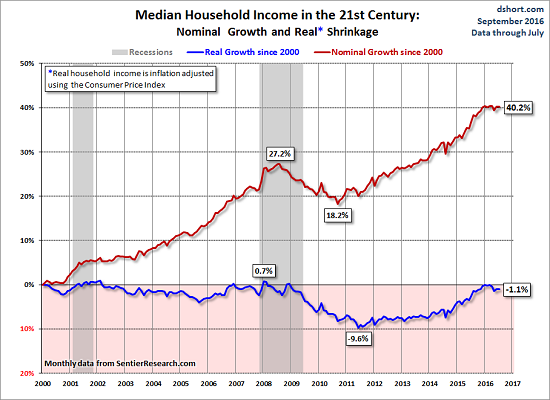
…click on the above link to read the rest of the article…
Technologies such as the blockchain are enabling alternative ways of creating and distributing money outside central banks and states.
If we don’t change the way money is created and distributed, we will never change anything. This is the core message of my book A Radically Beneficial World: Automation, Technology and Creating Jobs for All.
The Panama Papers offer damning proof of this: increasing concentrations of wealth and power that are free of any constraint (such as taxes) is not just the consequence of centralized money and state power–this inequality is the only possible output of centralized money and state power.
Here is a graphic portrayal of just how concentrated global wealth really is: the top .7% (less than 1%) own 45% of all global wealth, and the top 8% own 85%.
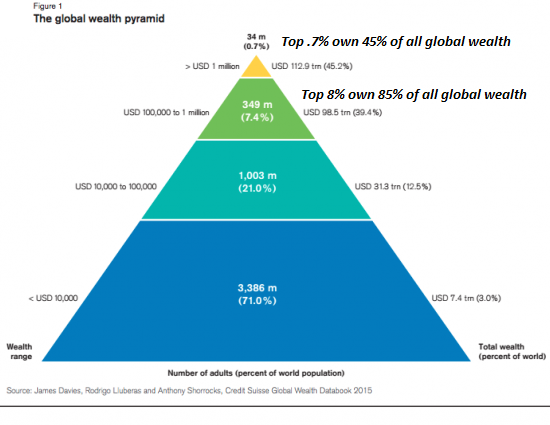
Here is a depiction of wealth in the U.S.:
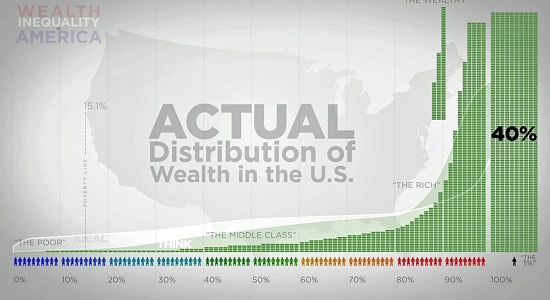
Here is my description of how centralized money and finance inevitably creates debt-serfdom as its only possible output:
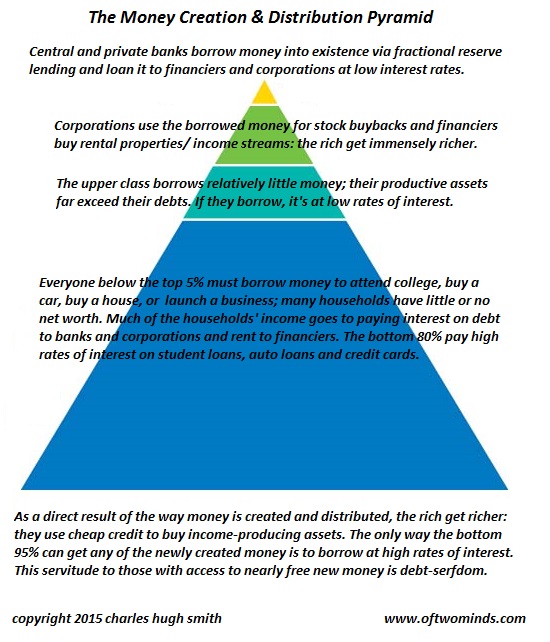
…click on the above link to read the rest of the article…
This morning on CBC Newsworld business reporter John Northcott was describing, in horror, a recent OXFAM report indicating that 62 of the world’s richest people have as much wealth combined ($1.76 trillion) as the poorest half of the planet (3.625 billion). Mr. Northcott and lead anchor Suhana Meharchand made comments about the unfairness of this distribution of wealth. Indeed, if only that amount of wealth could be distributed evenly, this would solve so many of the poverty problems in the world.
One of the benefits of studying economics is the insight it provides in identifying, precisely, how wealth is created and the logical consequences of legally expropriating created wealth and transferring it to other individuals.
The only way that wealth can be created in a free market is producing at profit something that satisfies the wants of your fellow man. Profit is the signal that resources are being used efficiently in production. If a person cannot produce a good or service at a profit, this reveals that costs are too high, the price consumers wish to pay is too low (they have other, more urgent priorities) or both. In other words, losses reflect that resources (including the labour of the resource owners the entrepreneurs bringing necessary inputs together) are not being put to their highest valued used as judged by consumers.
That 62 of the richest people have generated $1.76 trillion is something to be celebrated, not denigrated. A moments thought to how much poorer would be not only the 3.625 billion, but everyone else too if individuals like Bill Gates never created Microsoft. Without Bill Gate’s magnificent impact on humanity I could have been typing this on an Olympia manual typewriter. If #62 ranked Bill Li of China never developed his Chinese internet search engine, countless numbers of welfare improving transactions in China would not occur.
…click on the above link to read the rest of the article…
Over the holidays, I had the opportunity to stay away from airports and hike Runyon Canyon with my dogs. For those of you that have never traversed Runyon’s peaks and dips, they are nature’s respite from the urban streets of Los Angeles, yet located in the heart of the City of Angels. It’s a place in which to observe, reflect, and think about what’s coming ahead.
As a writer and journalist covering the ebbs and flows of government, elite individual, central bank and private industry power, actions, co-dependencies, and impacts on populations and markets worldwide, I often find myself reacting too quickly to information. As I embark upon extensive research for my new book, Artisans of Money, my resolution for the book – and the year – is to more carefully consider small details in the context of the broader perspective. My travels will take me to Brazil, Mexico, China, Japan, Germany, Spain, Greece and more. My intent is to converse with people in their respective locales; those formulating (or trying to formulate) monetary, economic and financial policy, and those affected by it.
We are currently in a transitional phase of geo-political-monetary power struggles, capital flow decisions, and fundamental economic choices. This remains a period of artisanal (central bank fabricated) money, high volatility, low growth, excessive wealth inequality, extreme speculation, and policies that preserve the appearance of big bank liquidity and concentration at the expense of long-term stability. The potential for chaotic fluctuations in any element of the capital markets is greater than ever.
…click on the above link to read the rest of the article…
I wrote the first three parts of this article back in September and planned to finish it in early October, but life intervened and truthfully I don’t think I was ready to confront how bad things will likely get as this Fourth Turning moves into the violent, chaotic war stage just over the horizon. The developments in the Middle East, Europe, U.S., China and across the globe in the last months have confirmed my belief war drums are beating louder, global war beckons, and much bloodshed will be the result. Fourth Turnings proceed at their own pace within the 20 to 25 year crisis framework, but there is one guarantee – they never de-intensify as they progress. Just as Winter gets colder, stormier and more bitter as you proceed from December through February, Fourth Turnings get nastier, grimmer, more perilous, with our way of life hanging in the balance.
In Part 1 of this article I discussed the catalyst spark which ignited this Fourth Turning and the seemingly delayed regeneracy. In Part 2 I pondered possible Grey Champion prophet generation leaders who could arise during the regeneracy. In Part 3 I focused on the economic channel of distress which is likely to be the primary driving force in the next phase of this Crisis. In Part 4 I will assess the social and cultural channels of distress dividing the nation, Part 5 the technological, ecological, political, military channels of distress likely to burst forth with the molten ingredients of this Fourth Turning, and finally in Part 6 our rendezvous with destiny, with potential climaxes to this Winter of our discontent.
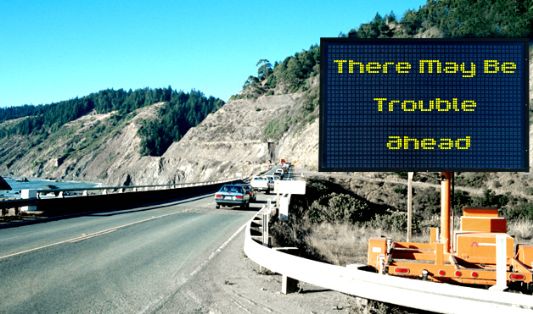
The road ahead will be distressful for everyone living in the U.S., as we experience the horrors of war, economic collapse, civil chaos, political upheaval, and the tearing of society’s social fabric. The pain and suffering being experienced across the globe today will not bypass the people of the United States.
…click on the above link to read the rest of the article…
Here’s what’s obvious, but unacceptable: we need a new system.
Pundits and apologists are quick to chastise anyone who even speaks of class war, as if the words alone might spark what the pundits and apologists fear.
The pundits and apologists dread the words because they know the Class War has already started. The mainstream media’s hope is that denial will somehow suppress the broader recognition that the fault lines in American society are cracking wide open.
Last week’s entries explained why increasing wealth/income inequality is the only possible output of the current social- political -economic order. All the proposed “fixes”–more regulations, more taxes, more bureaucracies, etc.– will fail because they are merely extensions of a failed system that optimizes inequality, monopoly, cronyism, stagnation, low social mobility and systemic instability.
Here is my delineation of America’s nine socio-economic classes:
The Changing World of Work I: America’s Nine Classes: Eight of the nine classes are hidebound by backward-looking conventions, neofeudal arrangements and a spectrum of perverse incentives and false choices.
A few commentators see the fault lines and understand the Class War is already rumbling. Correspondent Mark G. submitted these two articles as examples of the widening divides between various classes in the U.S.:
Are We Heading for an Economic Civil War?
How the widening urban-rural divide threatens America
In the first piece, Joel Kotkin describes the political capture of the Status Quo Imperial Democrats by the Left Coast media and tech culture of Silicon Valley and Hollywood, both of which have thrived in our hyper-financialized economy of 95% losers and 5% winners, and the Right Coast financiers, lobbyists, government bureaucrats and Wall Streeters who have benefited so handsomely from the hyper-financialization of the U.S. economy, politics, media and zeitgeist.
…click on the above link to read the rest of the article…
Centrally issued money optimizes inequality, monopoly, cronyism, stagnation, low social mobility and systemic instability.
If we don’t change the way money is created and distributed, wealth inequality will widen to the point of social disorder.
Everyone who wants to reduce wealth inequality with more regulations and taxes is missing the key dynamic: the monopoly on creating and issuing money necessarily widens wealth inequality, as those with access to newly issued money can always outbid the rest of us to buy the engines of wealth creation.
Control of money issuance and access to low-cost credit create financial and political power. Those with access to low-cost credit have a monopoly as valuable as the one to create money.
Compare the limited power of an individual with cash and the enormous power of unlimited cheap credit.
Let’s say an individual has saved $100,000 in cash. He keeps the money in the bank, which pays him less than 1% interest. Rather than earn this low rate, he decides to loan the cash to an individual who wants to buy a rental home at 4% interest.
There’s a tradeoff to earn this higher rate of interest: the saver has to accept the risk that the borrower might default on the loan, and that the home will not be worth the $100,000 the borrower owes.
The bank, on the other hand, can perform magic with the $100,000 they obtain from the central bank. The bank can issue 19 times this amount in new loans—in effect, creating $1,900,000 in new money out of thin air.
This is the magic of fractional reserve lending. The bank is only required to hold a small percentage of outstanding loans as reserves against losses. If the reserve requirement is 5%, the bank can issue $1,900,000 in new loans based on the $100,000 in cash: the bank holds assets of $2,000,000, of which 5% ($100,000) is held in cash reserves.
…click on the above link to read the rest of the article…
Epsilon Theory’s Ben Hunt is one of our favorite commentators and market analysts. He is a very rational, even-keeled and objective observer and trader of the capital markets, no matter how broken or centrally-planned they may be. Which is why we were disappointed to see that the two most recent appearances by the world’s foremost central-planners, Draghi and Yellen, managed to incense him as much as they did.
From Ben Hunt of Salient Partners (pdf)
Funny How?
I was watching the Draghi press conference the other week, and I had to turn off the TV. I found myself getting so … angry … not just at what Draghi was saying, but also the live blog reaction and the live market reaction, that I decided I was better off stepping back from the actual event and trying to figure out why I was having such a powerfully negative emotional reaction to the entire charade. It’s not the charade itself. I mean, if I were outraged by every inauthentic display of central banker “communication policy” and the media lapdog response, I’d be in some sort of permanent apoplectic fit. In fact, neither the central bankers nor the media even pretend any more that extraordinary monetary policy has any sort of material impact on the real economy, which I suppose is actually progress on the authenticity scale in a perverse sort of way.
I travel a lot speaking to investors and allocators of all sizes and political persuasions. I also read a lot from a wide variety of sources, also of all sizes and political persuasions. What I’m seeing and hearing on every issue that concerns capital markets and economics is not only an accelerated polarization of policy views between the left and the right (greater “distance” between the views), but also – and more troubling – a polarization (and in many cases a non-modal distribution) of policy views within the left and the right. The kicker: I think that this polarization is almost entirely driven by monetary policy and the power/wealth inequalities it creates.
…click on the above link to read the rest of the article…
If you want to understand why Rome declined, look no further than the moral decay of ruling Elites.
There are many reasons why Imperial Rome declined, but two primary causes that get relatively little attention are moral decay and soaring wealth inequality. The two are of course intimately connected: once the morals of the ruling Elites degrade, what’s mine is mine and what’s yours is mine, too.
I’ve previously covered two other key characteristics of an empire in terminal decline: complacency and intellectual sclerosis, what I have termed a failure of imagination.
Michael Grant described these causes of decline in his excellent account The Fall of the Roman Empire, a short book I have been recommending since 2009:
There was no room at all, in these ways of thinking, for the novel, apocalyptic situation which had now arisen, a situation which needed solutions as radical as itself. (The Status Quo) attitude is a complacent acceptance of things as they are, without a single new idea.
This acceptance was accompanied by greatly excessive optimism about the present and future. Even when the end was only sixty years away, and the Empire was already crumbling fast, Rutilius continued to address the spirit of Rome with the same supreme assurance.
This blind adherence to the ideas of the past ranks high among the principal causes of the downfall of Rome. If you were sufficiently lulled by these traditional fictions, there was no call to take any practical first-aid measures at all.
A lengthier book by Adrian Goldsworthy How Rome Fell: Death of a Superpoweraddresses the same issues from a slightly different perspective.
Glenn Stehle, commenting on 9/16/15 on a thread in the excellent website peakoilbarrel.com (operated by the estimable Ron Patterson) made a number of excellent points that I am taking the liberty of excerpting: (with thanks to correspondent Paul S.)
…click on the above link to read the rest of the article…
This chart of median household income illustrates why so many of us feel poorer–we are poorer in terms of the purchasing power of our income.
A rising tide raises all boats, from rowboats to yachts–this is the narrative of “prosperity.”
A rising tide is also the political cover for rising inequality: if the guy in the rowboat makes $100 more a month, he feels like he’s participating in the prosperity.
Meanwhile, the guy in the speedboat is making $1,000 more a month and the guy in the yacht is making $1 million more a month.
But this doesn’t bother the guy in the rowboat, for two reasons:
1. He thinks of himself as a guy who is currently in a rowboat on his way to buying a speedboat
2. Studies have found that our sense of wealth and “falling behind” is not defined by our actual increases in income or wealth, but by how we’re doing relative to our peer group. If everyone else in rowboats is making $200 more a month in the rising tide of prosperity, the guy making only $100 more feels like he’s falling behind–even if his absolute income and wealth is rising.
Conversely, if his peers are all suffering declines in income while his income is holding steady, he feels like he’s doing pretty well for himself, even though his income is stagnant.
The fact that the wealthy are gaining far more in “prosperity” in both absolute and relative terms doesn’t bother him as long as he’s doing as well or better as his peers and feels he has a chance to eventually move up from a rowboat to a speedboat.
…click on the above link to read the rest of the article…
There is democratic capitalism, and there is fascist capitalism. What we have today is fascist capitalism; and the following will explain how it works, using as an example the case of Greece.
Mark Whitehouse at Bloomberg headlined on 27 June 2015, “If Greece Defaults, Europe’s Taxpayers Lose,” and presented his ‘news’ report, which simply assumed that, perhaps someday, Greece will be able to get out of debt without defaulting on it. Other than his unfounded assumption there (which assumption is even in his headline), his report was accurate. Here is what he reported that’s accurate:
He presented two graphs, the first of which shows Greece’s governmental debt to private investors (bondholders) as of, first, December 2009; and, then, five years later, December 2014. This graph shows that, in almost all countries, private investors either eliminated or steeply reduced their holdings of Greek government bonds during that 5-year period. (Overall, it was reduced by 83%; but, in countries such as France, Portugal, Ireland, Austria, and Belgium, it was reduced closer to 100% — all of it.) In other words: by the time of December 2009, word was out, amongst the aristocracy, that only suckers would want to buy it from them, so they needed suckers and took advantage of the system that the aristocracy had set up for governments to buy aristocrats’ bad bets — for governments to be suckers when private individuals won’t. Not all of it was sold directly to governments; much of it went instead indirectly, to agencies that the aristocracy has set up as basically transfer-agencies for passing junk to governments; in other words, as middlemen, to transfer unpayable debt-obligations to various governments’ taxpayers.
…click on the above link to read the rest of the article…
CURRENT REALITIES:
Wealthiest Tenth (10%) of Americans Own 75% of America; They Draw 40% of All U.S. Income.
Wealthiest Hundredth (1%) of Americans Own 43% of America; They Draw 20% of All U.S. Income.
Wealthiest Thousandth (0.1%) of Americans Own 22% of America; They Draw 8% of All U.S. Income.
Wealthiest Ten-Thousandth (0.01%) Own 11.2% of America; They Draw 5% of All U.S. Income.
Wealthiest 0.0025% (Forbes 400) Own 2.75% (of all trackable privately-held wealth, not including ‘non-profits’ that are controlled by them).
That last (2.75%) is this $2.29 trillion divided by this $83,296 billion (representing all of the privately owned wealth in the U.S.), in the final quarter of 2014.
Incidentally, the wealthiest tenth are worth over $1 million and draw incomes above $200,000; so: they’re all “millionaires” in common parlance; all of the “top 10%” are.
Following will be mirror-images of the above-cited breakdowns:
Poorest 90% of Americans Own 25% of America; They Draw 60% of All U.S. Income.
Poorest 99% of Americans Own 57% of America; They Draw 80% of All U.S. Income.
Poorest 99.9% of Americans Own 78% of America; They Draw 92% of All U.S. Income.
Poorest 99.99% of Americans Own Less Than 88.8% of America; They Draw Less Than 95% of All U.S. Income.
Poorer 50%: Comprehensive figures for the wealthier and poorer 50% of Americans haven’t been published as recently. However, for the year 2010, the wealthier 50% of Americans owned 98.9% of America, and the poorer 50% of Americans owned 1.1% of America. That was the year after the crash had supposedly ended in 2009. The last prior year in that same study was 2007, the economic peak, and it showed the wealthier half owning 97.5% of America, and the poorer half owning 2.5% of it. In other words: the losses from the Wall Street economic crash went overwhelmingly to the poorer half of the U.S. population (their wealth going down from 2.5% to only 1.1% of America’s total), because of the bailouts to Wall Street.
…click on the above link to read the rest of the article…
Empire examines the rise and role of the new oligarchs and the decline of democracy in the United States and beyond.
Wealth inequality has risen to stratospheric heights. The statistics, the real statistics, sound like fragments spun off from a madman’s dream.
Eighty-five people have as much money as three and a half billion other people. Look at it like this: 85 people = 3,500,000,000 people.
Forbes Magazine, which used to gleefully refer to itself as a “capitalist tool,” creates an annual list of the richest 400 people in the world. Ten years ago, their combined wealth was $1,000,000,000,000 (one trillion dollars). Now, after a world wide crash and all sort of bailouts, their combined worth is $2,000,000,000,000. They have doubled their money. How have you done?
Did their money come to them because the magic of the market realised how ultra-special talented they were? Or because of power? Manipulating laws, buying politicians, even taking over governments. Has the power of money in the United States grown so great that democracy is just a charade? A large, frenetic, incredibly expensive one, but still, just play-acting and a dumb show for the public?
While all the real decisions come from a small group of the ultra-wealthy, to some degree very consciously, but to an even larger degree by the sheer weight of their incredible wealth, the Oligarchs.
That much money, it has to be about power.
…click on the above link to view the video…